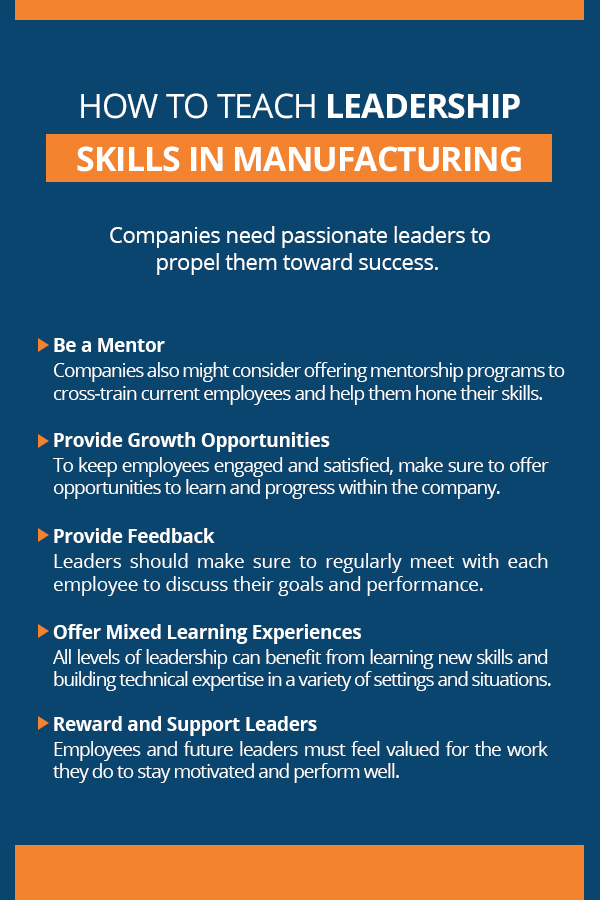Leadership in the Manufacturing Industry

The manufacturing industry is ever-changing. Manufacturers must keep up with technological advancements and absorb a constant influx of data to develop products customers demand. They must also comply with various rules and regulations, all while keeping employees motivated and safe. Being a leader in the manufacturing industry is not an easy task.
With that said, leaders can learn ways to be more effective and tackle everyday challenges while maintaining a positive frame of mind. In this article, we’ll explore the skills necessary to be a leader in today’s manufacturing world, and we’ll provide tips for leadership success.
How Manufacturing Is Changing
 Throughout the 20th century, manufacturing leadership focused mainly on improving quality. The goal was to obtain consistency in high-volume processes. Now, in the 21st century, product life cycles are shrinking, and quality is a given. Rather than focusing on consistency and perfection, manufacturers concentrate on creativity, innovation and speed. To meet modern demands, leaders must possess both soft and hard skills, such as technical expertise. In addition, today’s leaders must prioritize building relationships and offering unique solutions quickly.
Throughout the 20th century, manufacturing leadership focused mainly on improving quality. The goal was to obtain consistency in high-volume processes. Now, in the 21st century, product life cycles are shrinking, and quality is a given. Rather than focusing on consistency and perfection, manufacturers concentrate on creativity, innovation and speed. To meet modern demands, leaders must possess both soft and hard skills, such as technical expertise. In addition, today’s leaders must prioritize building relationships and offering unique solutions quickly.
How have these changes come about? Let’s look at four of the reasons manufacturing is no longer what it was a few decades ago.
1. Rapid Innovation
The internet has made the world a much smaller place and enables leaders, employees and customers to collaborate regardless of location or time of day. A global workforce that operates 24/7 inevitably speeds up innovation. As a result, leaders must be flexible and prepared to embrace new technology and ideas to keep up with competitors.
2. Data and Information
Leaders have access to more information and data than ever before. To succeed in their role, leaders must be interested in data security and using data to predict future product demand and performance. Leaders must be open to learning, and driven to make decisions based on relevant data.
3. Robotics
Thanks to robotics and automation, manufacturers are producing much more than previous decades. Leaders throughout the manufacturing sector can expect to see an increase in robotics use. For example, in 2013, there were around 1.2 million robots used in industry. This number increased to 1.9 million in 2017. Leaders must be able to solve problems related to advanced machinery as they arise, and they must be able to help employees use new technology in the most efficient way possible. This requires an understanding of advanced machinery and an appreciation for technology.
4. Need for Conservation
Within the manufacturing sector, leadership has to account for conservation of natural resources. The industrial sector relies heavily on energy resources to operate machinery and equipment. According to the U.S. Energy Information Administration (EIA), the industrial sector accounted for nearly a third of total U.S. energy consumption in 2017. Leaders need to consider ways to improve energy efficiency and reduce their carbon footprint, and this must be part of their decision-making process. Greater efficiency reduces production cost and increases energy resources.
How to Be a Leader in Manufacturing
 Although manufacturers have seen drastic change over the past several decades, their ultimate goals remain the same — to build their business. To be successful, leaders have to embrace data and technology, and they also need to possess traits that have helped business leaders succeed for many years. Anyone who desires to become an effective leader should focus on developing the following characteristics.
Although manufacturers have seen drastic change over the past several decades, their ultimate goals remain the same — to build their business. To be successful, leaders have to embrace data and technology, and they also need to possess traits that have helped business leaders succeed for many years. Anyone who desires to become an effective leader should focus on developing the following characteristics.
1. Honesty
Honesty is perhaps the most valuable characteristic of a leader because honesty builds trust. Employees won’t feel motivated to do their best work if they don’t trust their leaders. Honesty is an essential element in building strong relationships and getting everyone on the same page to reach a common goal. When leaders are honest with employees, they will earn their respect, and employees will be more apt to trust and follow their guidance.
Part of being an honest leader is also being honest with oneself. Leaders need to recognize their strengths and weaknesses and become more self-aware. When a leader is willing to admit their shortcomings, they’re more likely to ask for assistance when needed rather than try to do it all. As a result, honesty promotes teamwork and efficient problem-solving.
2. Integrity
Integrity is another valuable component of building trust. Employees and leaders consider integrity a critical element of leadership because employees want to work for individuals who are ethical and treat them fairly. Employees are also more likely to be committed to their work if their leaders value integrity. Overall, integrity helps a business grow because it attracts customers, investors and skilled professionals.
Leaders have the job of modeling and reinforcing integrity for everyone in a company. Here are a few ways a leader can set an example and create a culture built around integrity:
- Be honest and treat others with respect
- Praise contributions
- Treat everyone fairly
- Hold yourself accountable
- Consider leaders you admire and how you can develop similar traits
- Discover how employees view you, and how you can improve
- Admit mistakes
3. Vision
Leaders must clearly see their goals to direct others to follow them. Having a strong, clear vision helps leaders energize employees and understand the purpose of their work. Everyone will feel more motivated to succeed when they share a common vision. A leader must be able to articulate their dream if they want others to be part of the mission.
Having a vision also helps attract talented workers. This is because vision can help set a company apart from competitors. Any company can share a vision with their employees no matter what they manufacture. To establish a vision that motivates workers, leaders must create a vision that:
- Clearly defines purpose
- Applies to all employees
- Inspires loyalty
- Displays the strengths, values and beliefs of the company
- Generates enthusiasm
- Encourages commitment
- Helps employees recognize their value in the company
- Help employees believe they are part of something bigger than themselves
- Is part of regular communication and not just something shared in monthly meetings
- Is the reason actions are taken such as hiring employees or developing new products
- Challenges employees and inspires them to be their best
4. Knowledge
To understand and effectively lead employees, leaders must know what’s going on in the day-to-day. Without understanding what happens on the floor, leaders run the risk of losing employees’ trust.
Leaders must also have some level of technical knowledge to be successful. They need to be able to think critically and solve problems even as they acquire new machinery. Knowledge helps leaders evaluate information and make the best decisions possible. They also have to know how to communicate their objectives with others.
Leaders should make it a goal to stay on top of industry news and learn to embrace innovation. They must be open to learning new skills and information, and make it a priority to be an expert in their field. The first step to building knowledge as a leader is learning what skills are needed to be an effective leader within a particular role.
Manufacturing Leadership Tips
Even the world’s greatest leaders could use a few leadership tips now and then. Here are some tips leaders can use to expand their capabilities:
- Set an Example: Leaders should strive to be what they want their followers to be. If a leader wants their employees to work hard, they must show that they work hard themselves. When employees see their leaders practice what they preach, they will be much more likely to follow.
- Focus on Solutions: Effective leadership requires the ability to focus on solving problems rather than worrying about issues. Leaders need to know how to prioritize and take care of the most critical problems first.
- Be Accountable: Great leaders take responsibility for themselves and their team when they make mistakes. By taking responsibility for their actions, leaders gain trust and demonstrate integrity.
- Encourage Growth and Development: An effective leader must know how to recognize when it’s time to train or coach their team. This helps build teamwork and promotes productivity and growth.
- Communicate Effectively: Leaders must possess strong communication skills. Being a good communicator requires the ability to express ideas and listen carefully. Leaders should be direct and clear when they speak. They should also actively listen to employees’ concerns and provide regular feedback. Lastly, it’s essential for leaders to share company news and updates with employees, so employees don’t feel left in the dark about their performance or future.
- Be Courageous: As workplaces change, leaders must be willing to face new challenges and show confidence in their ability to adapt. Employees will be more motivated to adapt to change if they see their leaders embracing change. Leaders should remind employees of the company’s vision to keep motivation high.
- Be Confident: It can be hard to feel confident at all times, especially when facing new challenges. Nevertheless, leaders must practice projecting confidence. Employees rely on leaders to provide answers and security whether there are obstacles or not. Leaders must believe they have the skills needed to lead employees. It also helps to have a sense of humor sometimes and practice positive thinking.
- Keep Improving: To be an effective leader, one must be open to continually improving and learning. Leaders should also be open to new ideas and innovation.
- Be Empathetic: Leaders must use their heads and their hearts. They must be sensitive to diverse backgrounds and viewpoints to build relationships with employees and customers.
- Look for Root Causes: Leaders may be tempted to find the quickest fix to a problem. However, without getting to the root cause of an issue, the problem might return in the future and lead to downtime. Leaders should instead address the issue at the root and set an example for others to follow.
How to Teach Leadership Skills in Manufacturing
 Companies need passionate leaders to propel them toward success. Current leaders can prepare employees for future leadership roles and keep the company moving in the right direction. Here are some tips for helping employees grow:
Companies need passionate leaders to propel them toward success. Current leaders can prepare employees for future leadership roles and keep the company moving in the right direction. Here are some tips for helping employees grow:
- Be a Mentor: Leaders can be valuable mentors to employees and teach them skills and values specific to the company’s vision. Companies also might consider offering mentorship programs to cross-train current employees and help them hone their skills. Whether employees ultimately become leaders or not, a mentorship program can help motivate employees to be their best and see their full potential.
- Provide Growth Opportunities: Employees and potential leaders might not stick around long if they feel stagnant in their careers. To keep employees engaged and satisfied, make sure to offer opportunities to learn and progress within the company. For example, employers might offer paid training or host professional events. You can promote growth and development for employees in dozens of ways — employees are worth investing in.
- Provide Feedback: To help employees grow into leadership roles, they need to know their strengths and weaknesses. Leaders can help employees identify areas they need to work on by consistently communicating with them and providing regular feedback. Leaders should make sure to regularly meet with each employee to discuss their goals and performance. They should make employees feel comfortable and give them space to talk about their goals and concerns.
- Offer Mixed Learning Experiences: Management can help employees learn the skills and knowledge needed to be a successful leader by offering structured programs that provide a mix of classroom and hands-on learning. Adults retain only 30 to 40 percent of what they see and hear, while they retain 90 percent of what they see, hear and do. All levels of leadership can benefit from learning new skills and building technical expertise in a variety of settings and situations.
- Reward and Support Leaders: Employees and future leaders must feel valued for the work they do to stay motivated and perform well. For example, according to a survey conducted by the American Psychological Association (APA), 93 percent of employees who said they felt valued at work claimed to be motivated to perform their best, and 88 percent felt engaged. On the contrary, half of the employees who did not feel valued planned to look for a new job. To secure future leaders, management must remember that employees need a reason to stay. Current leaders should recognize employees’ accomplishments and provide incentives, like promotions or compensation, for becoming leaders.
Subscribe to Our Blog for the Latest Manufacturing Updates
 Companies thrive under the guidance and dedication of effective leaders. Regardless of changes in technology or the latest industry trends, great leaders have the power to keep employees engaged and bring the company’s vision to life. Today’s leaders must especially be willing to embrace change and be open to continuous self-improvement to keep up with the competition.
Companies thrive under the guidance and dedication of effective leaders. Regardless of changes in technology or the latest industry trends, great leaders have the power to keep employees engaged and bring the company’s vision to life. Today’s leaders must especially be willing to embrace change and be open to continuous self-improvement to keep up with the competition.
At Global Electronic Services, we’re proud to help your company stay up to speed. Subscribe to our blog and keep up with the latest news in manufacturing.